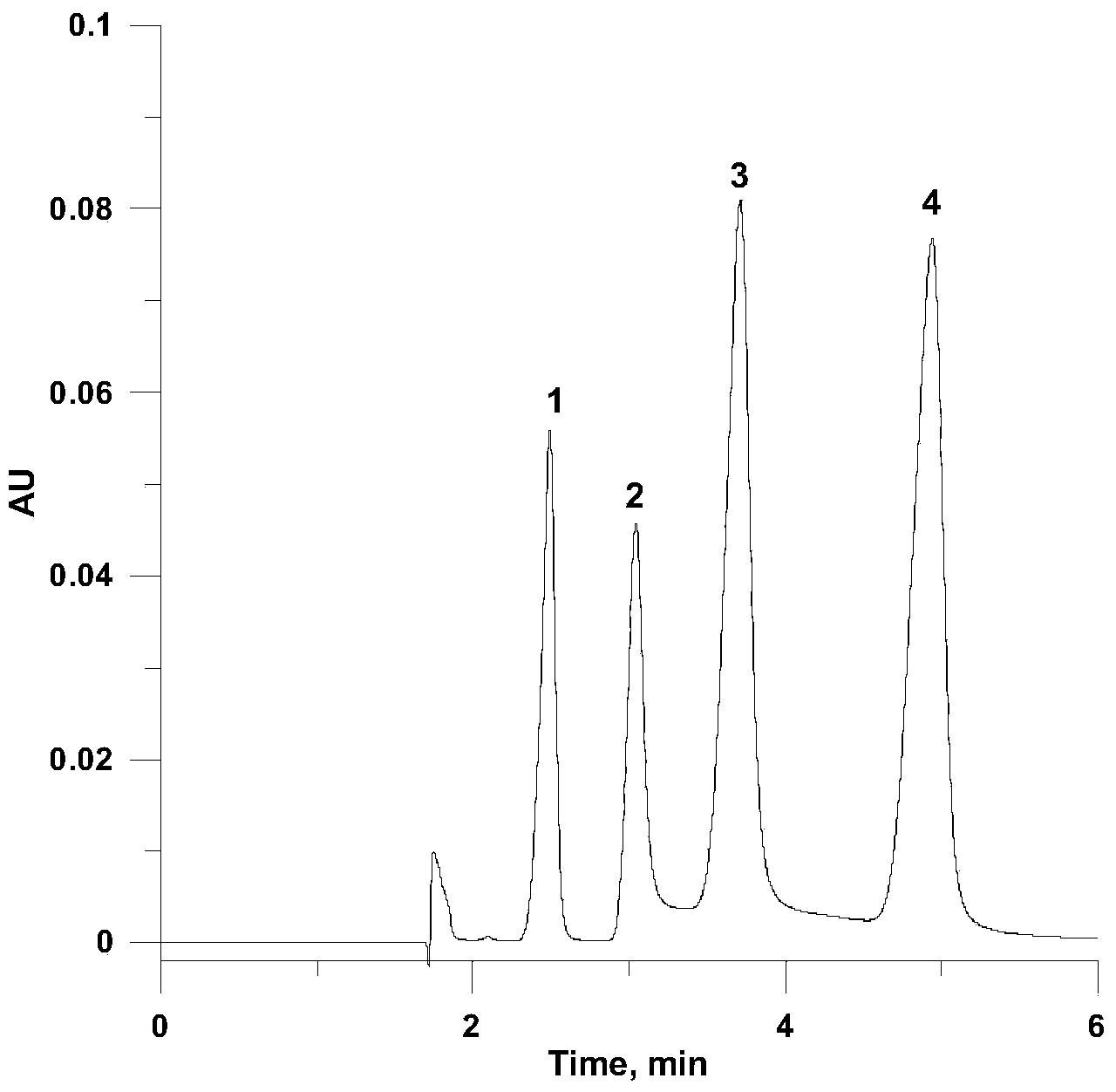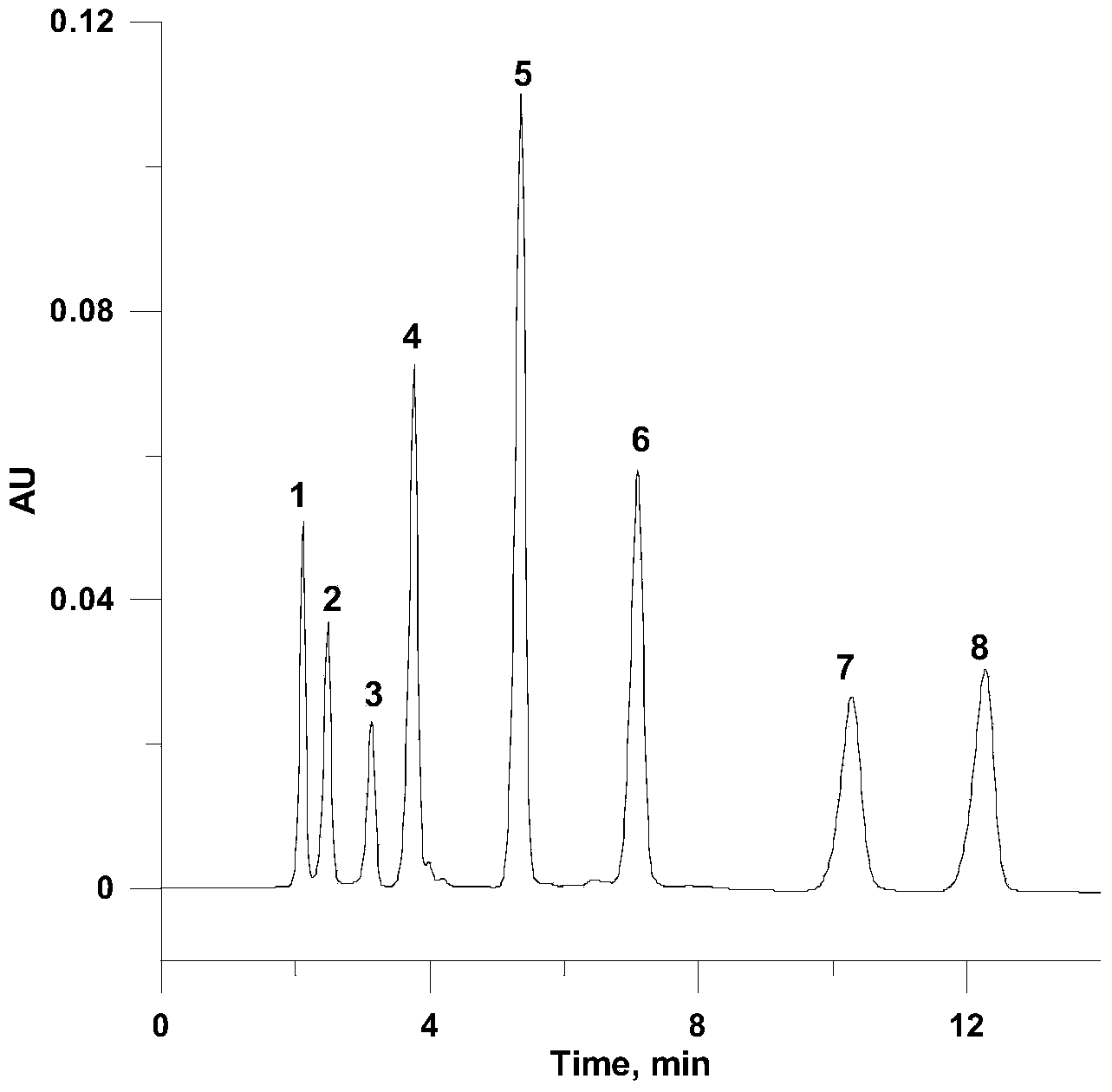Polyvinyl alcohol coating chromatography stationary phase as well as preparation method thereof and application
A chromatographic stationary phase and polyvinyl alcohol technology, which is applied in the field of polyvinyl alcohol-coated chromatographic stationary phases, can solve the problems of affecting the reproducibility of analysis results, the complex preparation process of the stationary phase, and the limited range of pH application, and achieve the design idea. Novel, technically applicable, good retention and effect of separation properties
- Summary
- Abstract
- Description
- Claims
- Application Information
AI Technical Summary
Problems solved by technology
Method used
Image
Examples
Embodiment 1
[0033] Weigh 1g of polyvinyl alcohol (PVA), add it into a 100mL round-bottomed flask to prepare a PVA aqueous solution with a concentration of 0.02g / mL, stir at 100°C and 1500rpm until the PVA is evenly dissolved, then add 3g of silica gel, and continue stirring at 300rpm for 20min , filter while hot with a sand core funnel, wash the solid product with water, put it in an oven and dry it at 140°C to obtain the stationary phase.
[0034] The obtained stationary phase filler was filled in a 4.6mm*150mm, I.D. stainless steel HPLC chromatographic column, and the prepared chromatographic column was used to test its retention and separation of strongly polar compounds in the hydrophilic chromatography mode and to separate mixed samples. The mobile phase is three phases, which are respectively acetonitrile, water, and 250 mM ammonium formate solution (pH is 3.51). The mobile phase conditions are that the volume ratio of acetonitrile, water and ammonium formate is 90 / 4 / 6, the flow rat...
Embodiment 2
[0036] The difference from Example 1 is that according to the synthesis steps of Example 1, the filtered solid product is first put into a refrigerator at -20°C and frozen to obtain a cold-polymerized polyvinyl alcohol stationary phase.
[0037] The chromatographic column obtained by packing the obtained stationary phase was used to separate samples in normal phase chromatography mode. The mobile phase condition was that the volume ratio of n-hexane and ethanol was 80 / 20. Four kinds of samples have been well separated, and the chromatogram is as shown in 2 (1 is phenol, 2 is o-diphenol, 3 is m-diphenol, 4 is 4-nitroaniline); Equally, prepared chromatographic column is in Separation of cephalosporin samples in hydrophilic interaction chromatography mode. Using acetonitrile, water, 250mM ammonium formate solution (pH 5.7) as the mobile phase, and gradient elution (water volume content: 0-60 minutes: 10-40%), the cephalosporin samples are well retained and separated , the chrom...
Embodiment 3
[0039] The difference from Example 2 is that sodium dodecyl sulfate (SDS) is added in the polyvinyl alcohol solution, and the chromatographic column packed with another polyvinyl alcohol stationary phase and this stationary phase can be obtained according to the synthetic steps of Example 1 . The sodium dodecyl sulfate (SDS) structural formula of this implementation is:
[0040]
[0041] The prepared chromatographic column was used to separate polycyclic aromatic hydrocarbon samples under the mode of reverse phase chromatography. The mobile phase conditions were methanol and water at a volume ratio of 20 / 80. The chromatogram is shown in 4 (1 is uracil, 2 is benzene, 3 is toluene, 4 is naphthalene, 5 is biphenyl, 6 is phenanthrene, 7 is pyrene).
PUM
 Login to View More
Login to View More Abstract
Description
Claims
Application Information
 Login to View More
Login to View More - R&D
- Intellectual Property
- Life Sciences
- Materials
- Tech Scout
- Unparalleled Data Quality
- Higher Quality Content
- 60% Fewer Hallucinations
Browse by: Latest US Patents, China's latest patents, Technical Efficacy Thesaurus, Application Domain, Technology Topic, Popular Technical Reports.
© 2025 PatSnap. All rights reserved.Legal|Privacy policy|Modern Slavery Act Transparency Statement|Sitemap|About US| Contact US: help@patsnap.com



